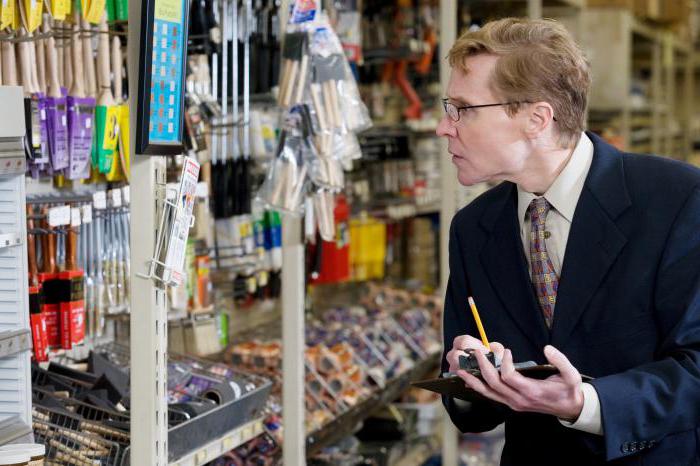Shortage is a fairly common concept in trade. It means that some product is missing. As a rule, this happens both in self-service stores and in ordinary counter points. There may be various reasons for this - inattention of sellers, dishonest buyers, various shrinkage and reassortment. We will examine in more detail in this matter.
An inventory is an audit, within the framework of which the amount of property of an institution is determined by a specific calendar number by reconciling accounting information with actual indicators. This method is a control method for the preservation of material assets, as well as property. If there is a shortage in the inventory, what should I do? How is it written off? In our article we will try to answer these and other questions that arise due to certain accounting features associated with the loss and damage of material values.
Surplus and shortage in accounting
In fact, in the framework of economic activity, many enterprises are faced with losses or shortages from damage to tangible assets. Under tangible assets and values should be understood such property of the institution as materials, stocks and fixed assets along with manufactured products, goods, cash and other valuable assets.
Such problems, as a rule, arise as a result of the abuse of materially responsible persons by the assets of the enterprise, and in addition, due to theft, accounting errors during the reception or shipment of tangible assets. A deficiency in the rate of natural attrition can also be detected. In trade organizations, a so-called reassortment often arises, which leads to the formation of surpluses of some goods and products and shortages of others.
Fixation can occur as part of the procurement of material assets along with their storage, movement, sale, as well as during the implementation of inventories. It must be remembered that monitoring the effectiveness of the use of resources, as well as the safety of the property of the enterprise is one of the important tasks of maintaining accounting in the organization.
The main thing is the timeliness of the audit
The responsibility for the rational use of resources of the institution is assigned to employees working with these goods and bearing direct material responsibility for them. At the same time, accounting provides and guarantees control over the movement, as well as the consumption of tangible assets, along with the compliance of the operations with current legislation. Thus, the timely conduct of an inventory in order to confirm the balances of inventories, as well as other valuable assets, is extremely necessary.
Inventory requirements and goals
In the process of inventory checks, the material values that are in storage are outweighed, recounted and measured. Also subject to valuation is cash on hand, and in addition, funds in circulation in production, in trade, and so on. In addition, an inventory is carried out for the following purposes:
- Identification of unused objects that should be implemented subsequently.
- If necessary, detect spoiled goods with an expired shelf life.
- Check and control of ensuring the safety of property and material assets.
Verification, as a rule, can be full or partial, but also planned or sudden. But in any situation, a number of the following requirements must be observed:
- Creating a surprise effect for a person who is liable in case of shortage of materials during the inventory.
- Establishment of a commission for verification.
- Direct conversion of values.
- Performing regular inspections with the mandatory participation of employees who are responsible for the safety of certain material values.
Immediately after the inventory procedure, its results are summarized, which are usually as follows:
- The total amount of the proposed property is fully consistent with the actual availability, and in addition, accounting data.
- Obvious surpluses have been identified.

Inventory shortage found? What to do in these cases? To start, write it off correctly. If, as a result of the inventory check, a shortage of something was revealed, then immediately difficulties arise with the paperwork. In order to write off correctly, you need to find out the cause of its occurrence. These may be the following factors:
- Production costs along with handling features.
- Losses resulting from the actions of perpetrators.
- Other costs in the formation of which the guilty employees were absent or to prove their guilt in court is not possible.
The deficit amount can be written off in various ways, which depends directly on the reason for its formation. In order to confirm production costs, as well as losses, appropriate documentation is required. In this case, we are talking about executed acts of damage to property and so on. As a rule, for the preparation of documentation use a standard form or developed independently.
Inventory procedure
Immediately before the inventory procedure, its order is prescribed in the accounting policy, which indicates the following information:
- Deadlines.
- Cases of carrying out.
- The composition of the commission. As a rule, the commission includes accountants, as well as other specialists who possess the required knowledge and qualifications. In addition to the fact that, in the framework of the inventory, the goods are not only counted, but also weighed and measured, they also analyze the property and financial obligations.
- Typical schemes for identifying surpluses or shortages.

In the order issued by the head of the organization, it is necessary to reflect information that will relate to the composition of the commission, and in addition, the duration of the audit and the types of property to be verified. The commission should not include persons who are financially liable and have any values to be verified in the sub-report. During the inventory, a solid or selective method can be used. The continuous methodology consists in the analysis and verification of all property and types of financial obligations of the institution. Selective type involves checking only certain types of property, for example, food.
Surplus or shortage in inventory? What to do?
They are documented at the end of the audit. The person responsible for this should indicate the actual amount of surplus or shortage. The document in which the surplus or shortage is written off must be accompanied by an act of verification and other documentation that confirms the actual quantity of goods available.
Paperwork for writing off
Write-off of shortages must be carried out taking into account the norms of natural attrition, as well as the policies of the institution.The natural decrease is written off only after accounting for this amount has been calculated, and in addition, after the procedure of checking the results by the management of the institution and an independent commission.
After that, a decision is made on the appropriateness of an official investigation to identify the perpetrators. Lack of inventory? What to do with workers whose fault it happened? To begin to figure it out. Investigation is especially necessary in situations where the amount of shortage significantly exceeds the rate of natural decline. The use of norms of natural attrition is provided for food products, for a total of any quantitative, and, in addition, high-quality goods, excluding packaged products and those that come in individually.
Write-off procedure
The identified shortage in the inventory must be written off as follows:
- During the year in which the audit was conducted.
- Only one person who is recognized as responsible for performing the inventory.
- The shortage of goods during the inventory is deducted from the property or goods having the same name.
- Write off from property or goods that are in the same quantity.
There is also a certain order that must be followed.
The shortfall in inventory is written off in the following order:
- It is necessary to receive an order to write off directly from the management of the enterprise.
- As part of this procedure, the residual value of fixed assets, the cost of finished goods and materials, the purchase price of goods, as well as transportation costs and labor costs of employees who carry out the inventory are written off. Write-off, as a rule, is carried out from the loan to the debit of account No. 94, which is called "Lack and loss of values."
- A comparison is made of the amount of expenses with the rates of loss after they are calculated in accounting. In the event that this amount is less than the norms of natural loss of food products and any other groups of goods, it can be written off to the expenses of the enterprise.
At the last stage, the issue of value added tax is resolved, which may or may not be restored. In the event that VAT is recoverable, a certain amount is shown on debit on credit.
Documentation
Based on the results of the inventory, the material assets that are available are verified with accounting documents. In the situation of identifying inconsistencies in the framework of weighing, measuring and recounting, they make an inventory or fill out the necessary document. In the event that deviations are detected, marks are made in the statement of discrepancy. The list of mandatory documents includes the following types of acts:
- "TORG-6" - the act of the curtain of packaging.
- TORG-7, which is a form for filling out the inventory register.
- "TORG-15" - an act to reflect low-quality goods and products.
- "TORG-16" includes information on the write-off of goods.
- "TORG-20" contains information on further actions with surplus or shortage.
- "TORG-21" - an act on the re-sorting of vegetables and fruits.
Consequences and liability
Who pays the shortage at the store, at the factory, at the enterprise or at any other place of its identification?
In the event that, according to the results of the inventory, a shortage of something is discovered, then the guilty employee is liable, which is subsequently obliged to compensate for the damage caused to the enterprise. If, for example, there is a shortage in the warehouse, the storekeeper is liable if he is a materially responsible person in accordance with the organization’s internal orders. To do this, first draw up a verification act confirming the fact of guilt in accordance with applicable law.If the guilty employee agrees with the amount of the shortage presented, he draws up an explanation, indicating his motives, as well as the reasons for causing material damage to the company.
He does not admit guilt
If the employee does not plead guilty, the employer convenes a commission in order to conduct an internal investigation. The commission establishes employee involvement in the fact of the deed. After that, they draw up an act of refusal to repay the lost amount by the perpetrator. Further, this act of failure shall be sent to the head of the company for consideration, who must decide to recover material damage from the employee by force. Then the head of the enterprise issues an order to withhold money from the guilty party’s salary partially or in full. After that, accounting can make the corresponding deductions.
During the calculation of losses, the purchase price of the missing goods is taken into account without taking into account the lost profit or obtaining the probable profit as a result of use. In the event that the employee does not agree with the deductions presented, he has the right to appeal this action by his employer in court.
In order to recover damage from the guilty person with whom an agreement on liability was not concluded, they file an application with the court along with evidence that confirms his guilt. If the employee’s guilt in the loss of goods has not been established, then in such a situation, compensation for losses or writing them off as expenses is simply impossible.
Finally
You can fully understand all such nuances only if you have the appropriate financial and accounting knowledge. This will provide an opportunity to correctly identify the shortage as part of the inventory check, as well as to hold accountable those who are actually to blame for its occurrence.